Counselling Skills with Children and Adolescents: An Overview
VerifiedAdded on 2019/12/03
|8
|2342
|323
Report
AI Summary
This report delves into the crucial counselling skills required when working with children and adolescents, focusing on the application of psychodynamic theory. It explores essential skills such as listening, talking, and expression, emphasizing their role in providing emotional support and fostering self-awareness. The report examines key concepts like first encounters and transference, highlighting their significance in understanding a child's past experiences and their impact on present behavior. Additionally, it discusses the use of play as a therapeutic tool, emphasizing its role in developing a therapeutic relationship and helping children express their emotions and address their problems. The report concludes by emphasizing the interconnectedness of counselling skills and psychodynamic theory, and how the effective use of these skills facilitates positive changes in the behavior of children and adolescents.
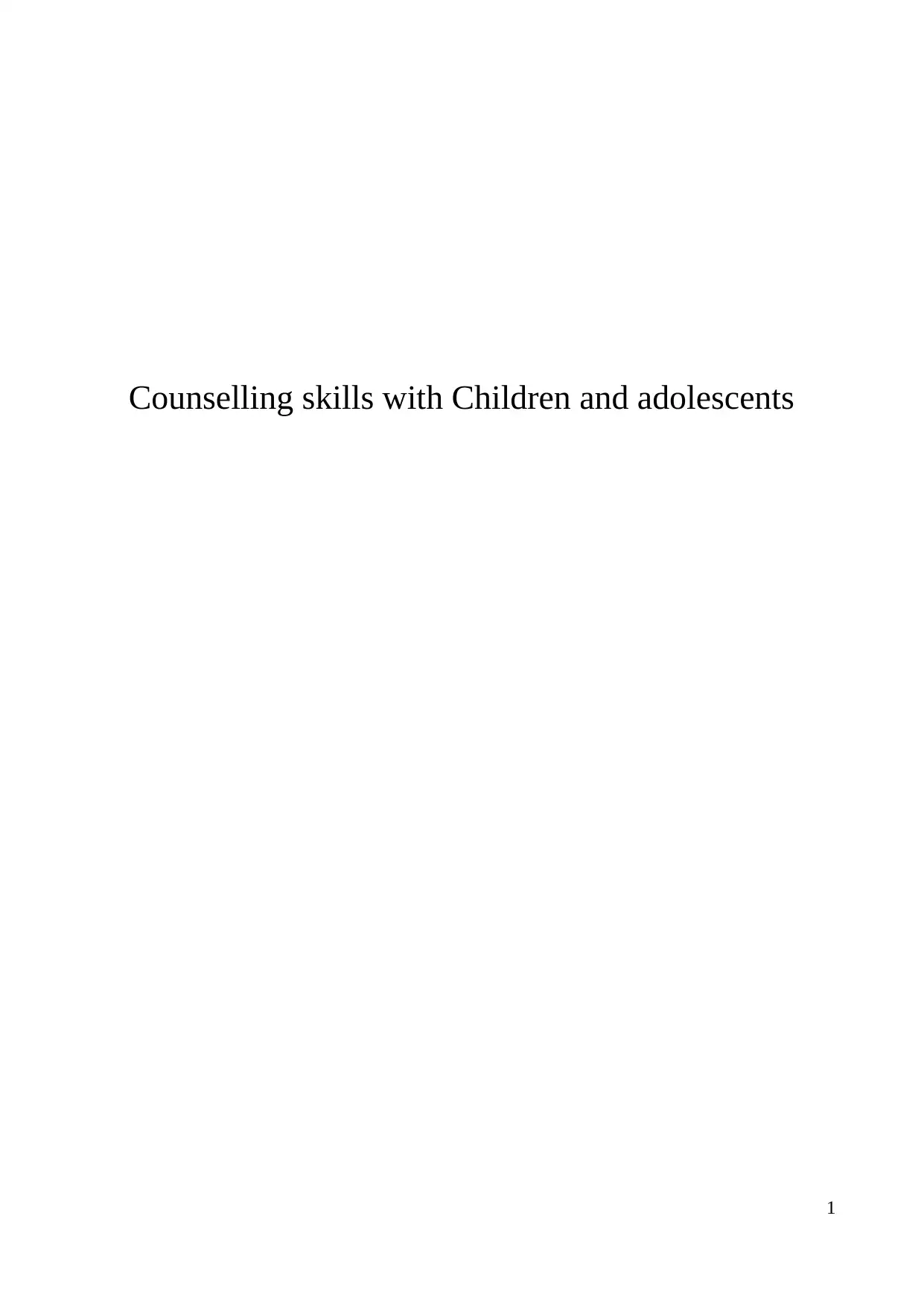
Counselling skills with Children and adolescents
1
1
Paraphrase This Document
Need a fresh take? Get an instant paraphrase of this document with our AI Paraphraser

Table of Contents
INTRODUCTION................................................................................................................................4
CONCLUSION....................................................................................................................................7
References............................................................................................................................................8
2
INTRODUCTION................................................................................................................................4
CONCLUSION....................................................................................................................................7
References............................................................................................................................................8
2
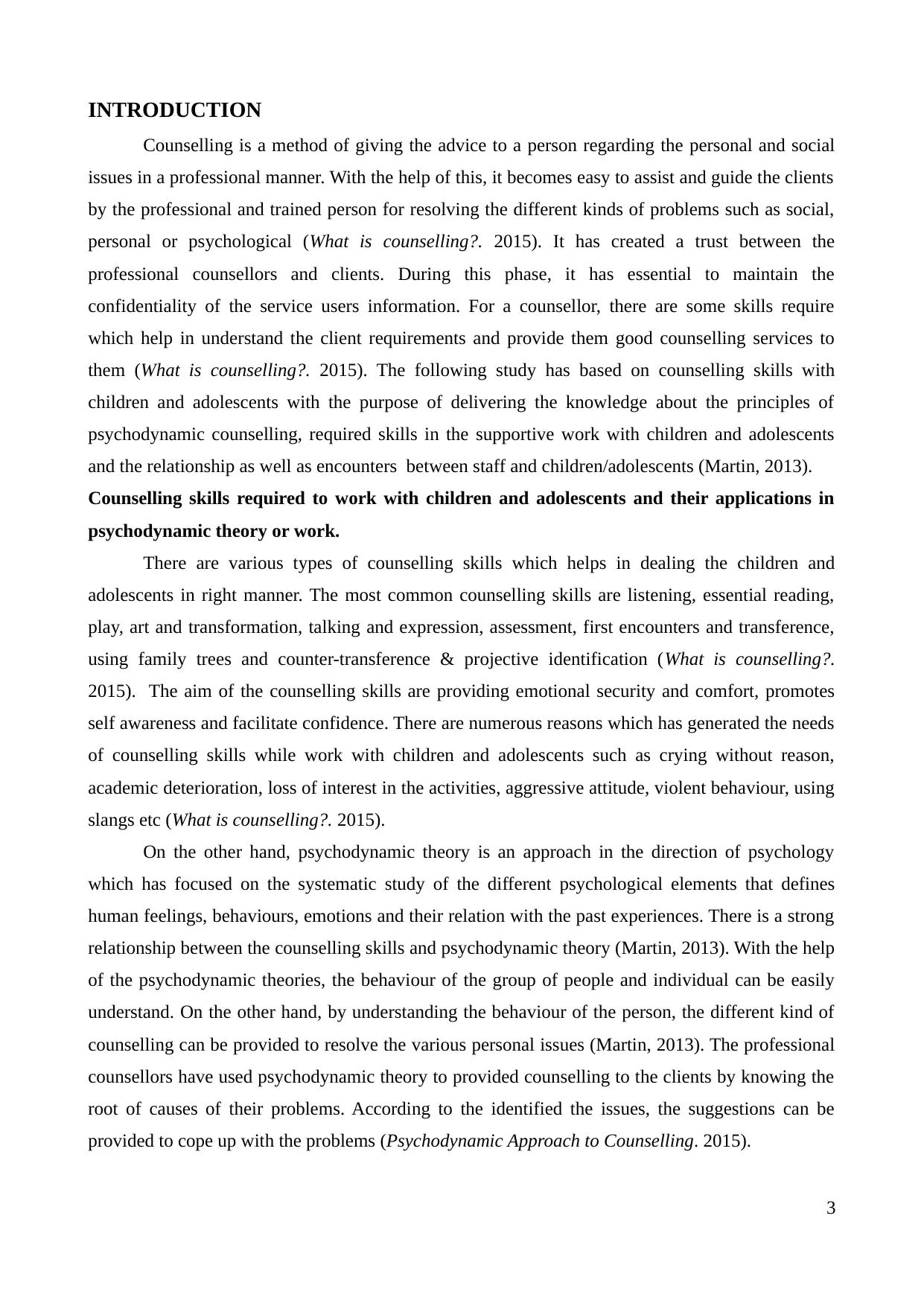
INTRODUCTION
Counselling is a method of giving the advice to a person regarding the personal and social
issues in a professional manner. With the help of this, it becomes easy to assist and guide the clients
by the professional and trained person for resolving the different kinds of problems such as social,
personal or psychological (What is counselling?. 2015). It has created a trust between the
professional counsellors and clients. During this phase, it has essential to maintain the
confidentiality of the service users information. For a counsellor, there are some skills require
which help in understand the client requirements and provide them good counselling services to
them (What is counselling?. 2015). The following study has based on counselling skills with
children and adolescents with the purpose of delivering the knowledge about the principles of
psychodynamic counselling, required skills in the supportive work with children and adolescents
and the relationship as well as encounters between staff and children/adolescents (Martin, 2013).
Counselling skills required to work with children and adolescents and their applications in
psychodynamic theory or work.
There are various types of counselling skills which helps in dealing the children and
adolescents in right manner. The most common counselling skills are listening, essential reading,
play, art and transformation, talking and expression, assessment, first encounters and transference,
using family trees and counter-transference & projective identification (What is counselling?.
2015). The aim of the counselling skills are providing emotional security and comfort, promotes
self awareness and facilitate confidence. There are numerous reasons which has generated the needs
of counselling skills while work with children and adolescents such as crying without reason,
academic deterioration, loss of interest in the activities, aggressive attitude, violent behaviour, using
slangs etc (What is counselling?. 2015).
On the other hand, psychodynamic theory is an approach in the direction of psychology
which has focused on the systematic study of the different psychological elements that defines
human feelings, behaviours, emotions and their relation with the past experiences. There is a strong
relationship between the counselling skills and psychodynamic theory (Martin, 2013). With the help
of the psychodynamic theories, the behaviour of the group of people and individual can be easily
understand. On the other hand, by understanding the behaviour of the person, the different kind of
counselling can be provided to resolve the various personal issues (Martin, 2013). The professional
counsellors have used psychodynamic theory to provided counselling to the clients by knowing the
root of causes of their problems. According to the identified the issues, the suggestions can be
provided to cope up with the problems (Psychodynamic Approach to Counselling. 2015).
3
Counselling is a method of giving the advice to a person regarding the personal and social
issues in a professional manner. With the help of this, it becomes easy to assist and guide the clients
by the professional and trained person for resolving the different kinds of problems such as social,
personal or psychological (What is counselling?. 2015). It has created a trust between the
professional counsellors and clients. During this phase, it has essential to maintain the
confidentiality of the service users information. For a counsellor, there are some skills require
which help in understand the client requirements and provide them good counselling services to
them (What is counselling?. 2015). The following study has based on counselling skills with
children and adolescents with the purpose of delivering the knowledge about the principles of
psychodynamic counselling, required skills in the supportive work with children and adolescents
and the relationship as well as encounters between staff and children/adolescents (Martin, 2013).
Counselling skills required to work with children and adolescents and their applications in
psychodynamic theory or work.
There are various types of counselling skills which helps in dealing the children and
adolescents in right manner. The most common counselling skills are listening, essential reading,
play, art and transformation, talking and expression, assessment, first encounters and transference,
using family trees and counter-transference & projective identification (What is counselling?.
2015). The aim of the counselling skills are providing emotional security and comfort, promotes
self awareness and facilitate confidence. There are numerous reasons which has generated the needs
of counselling skills while work with children and adolescents such as crying without reason,
academic deterioration, loss of interest in the activities, aggressive attitude, violent behaviour, using
slangs etc (What is counselling?. 2015).
On the other hand, psychodynamic theory is an approach in the direction of psychology
which has focused on the systematic study of the different psychological elements that defines
human feelings, behaviours, emotions and their relation with the past experiences. There is a strong
relationship between the counselling skills and psychodynamic theory (Martin, 2013). With the help
of the psychodynamic theories, the behaviour of the group of people and individual can be easily
understand. On the other hand, by understanding the behaviour of the person, the different kind of
counselling can be provided to resolve the various personal issues (Martin, 2013). The professional
counsellors have used psychodynamic theory to provided counselling to the clients by knowing the
root of causes of their problems. According to the identified the issues, the suggestions can be
provided to cope up with the problems (Psychodynamic Approach to Counselling. 2015).
3
⊘ This is a preview!⊘
Do you want full access?
Subscribe today to unlock all pages.

Trusted by 1+ million students worldwide
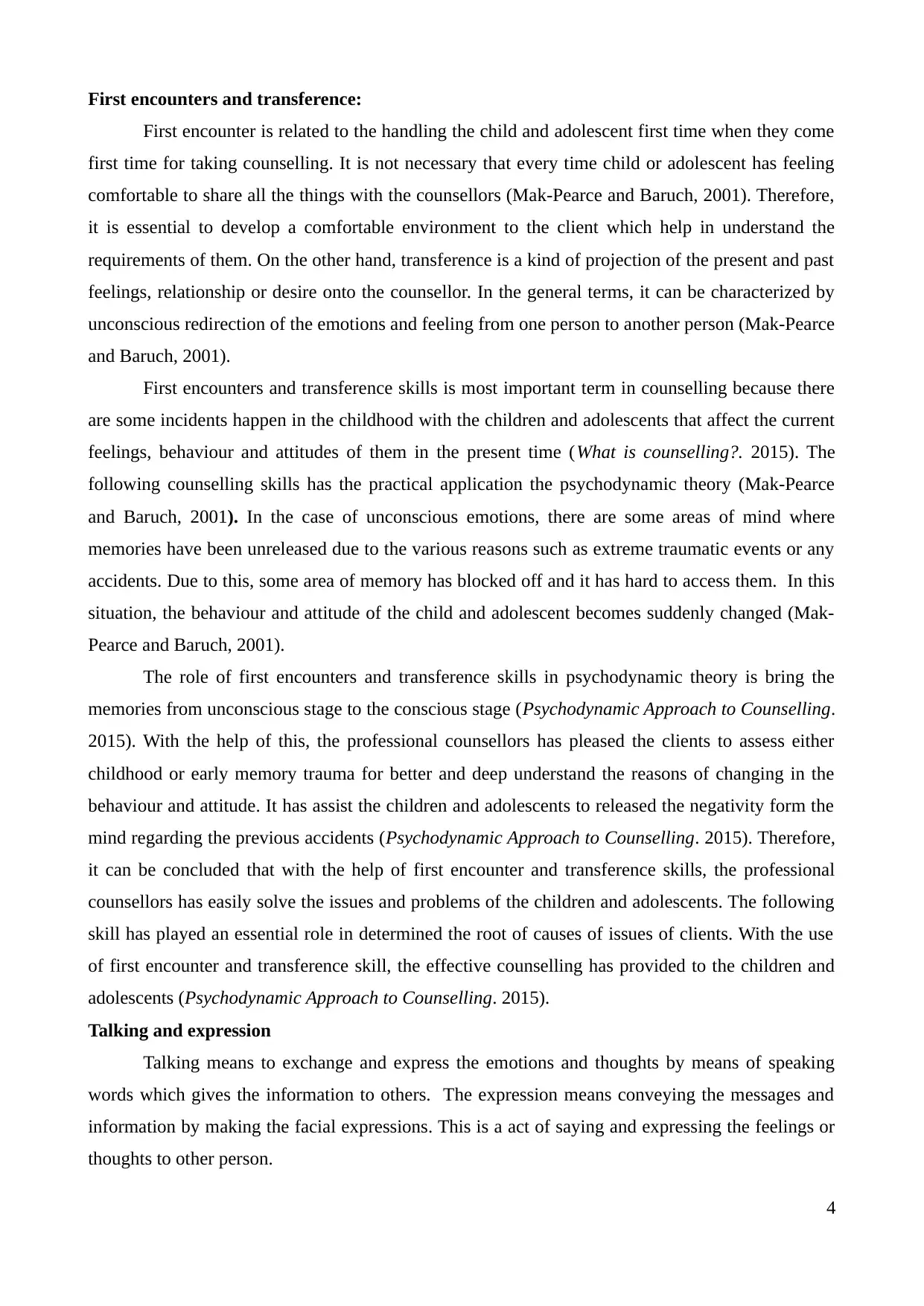
First encounters and transference:
First encounter is related to the handling the child and adolescent first time when they come
first time for taking counselling. It is not necessary that every time child or adolescent has feeling
comfortable to share all the things with the counsellors (Mak-Pearce and Baruch, 2001). Therefore,
it is essential to develop a comfortable environment to the client which help in understand the
requirements of them. On the other hand, transference is a kind of projection of the present and past
feelings, relationship or desire onto the counsellor. In the general terms, it can be characterized by
unconscious redirection of the emotions and feeling from one person to another person (Mak-Pearce
and Baruch, 2001).
First encounters and transference skills is most important term in counselling because there
are some incidents happen in the childhood with the children and adolescents that affect the current
feelings, behaviour and attitudes of them in the present time (What is counselling?. 2015). The
following counselling skills has the practical application the psychodynamic theory (Mak-Pearce
and Baruch, 2001). In the case of unconscious emotions, there are some areas of mind where
memories have been unreleased due to the various reasons such as extreme traumatic events or any
accidents. Due to this, some area of memory has blocked off and it has hard to access them. In this
situation, the behaviour and attitude of the child and adolescent becomes suddenly changed (Mak-
Pearce and Baruch, 2001).
The role of first encounters and transference skills in psychodynamic theory is bring the
memories from unconscious stage to the conscious stage (Psychodynamic Approach to Counselling.
2015). With the help of this, the professional counsellors has pleased the clients to assess either
childhood or early memory trauma for better and deep understand the reasons of changing in the
behaviour and attitude. It has assist the children and adolescents to released the negativity form the
mind regarding the previous accidents (Psychodynamic Approach to Counselling. 2015). Therefore,
it can be concluded that with the help of first encounter and transference skills, the professional
counsellors has easily solve the issues and problems of the children and adolescents. The following
skill has played an essential role in determined the root of causes of issues of clients. With the use
of first encounter and transference skill, the effective counselling has provided to the children and
adolescents (Psychodynamic Approach to Counselling. 2015).
Talking and expression
Talking means to exchange and express the emotions and thoughts by means of speaking
words which gives the information to others. The expression means conveying the messages and
information by making the facial expressions. This is a act of saying and expressing the feelings or
thoughts to other person.
4
First encounter is related to the handling the child and adolescent first time when they come
first time for taking counselling. It is not necessary that every time child or adolescent has feeling
comfortable to share all the things with the counsellors (Mak-Pearce and Baruch, 2001). Therefore,
it is essential to develop a comfortable environment to the client which help in understand the
requirements of them. On the other hand, transference is a kind of projection of the present and past
feelings, relationship or desire onto the counsellor. In the general terms, it can be characterized by
unconscious redirection of the emotions and feeling from one person to another person (Mak-Pearce
and Baruch, 2001).
First encounters and transference skills is most important term in counselling because there
are some incidents happen in the childhood with the children and adolescents that affect the current
feelings, behaviour and attitudes of them in the present time (What is counselling?. 2015). The
following counselling skills has the practical application the psychodynamic theory (Mak-Pearce
and Baruch, 2001). In the case of unconscious emotions, there are some areas of mind where
memories have been unreleased due to the various reasons such as extreme traumatic events or any
accidents. Due to this, some area of memory has blocked off and it has hard to access them. In this
situation, the behaviour and attitude of the child and adolescent becomes suddenly changed (Mak-
Pearce and Baruch, 2001).
The role of first encounters and transference skills in psychodynamic theory is bring the
memories from unconscious stage to the conscious stage (Psychodynamic Approach to Counselling.
2015). With the help of this, the professional counsellors has pleased the clients to assess either
childhood or early memory trauma for better and deep understand the reasons of changing in the
behaviour and attitude. It has assist the children and adolescents to released the negativity form the
mind regarding the previous accidents (Psychodynamic Approach to Counselling. 2015). Therefore,
it can be concluded that with the help of first encounter and transference skills, the professional
counsellors has easily solve the issues and problems of the children and adolescents. The following
skill has played an essential role in determined the root of causes of issues of clients. With the use
of first encounter and transference skill, the effective counselling has provided to the children and
adolescents (Psychodynamic Approach to Counselling. 2015).
Talking and expression
Talking means to exchange and express the emotions and thoughts by means of speaking
words which gives the information to others. The expression means conveying the messages and
information by making the facial expressions. This is a act of saying and expressing the feelings or
thoughts to other person.
4
Paraphrase This Document
Need a fresh take? Get an instant paraphrase of this document with our AI Paraphraser
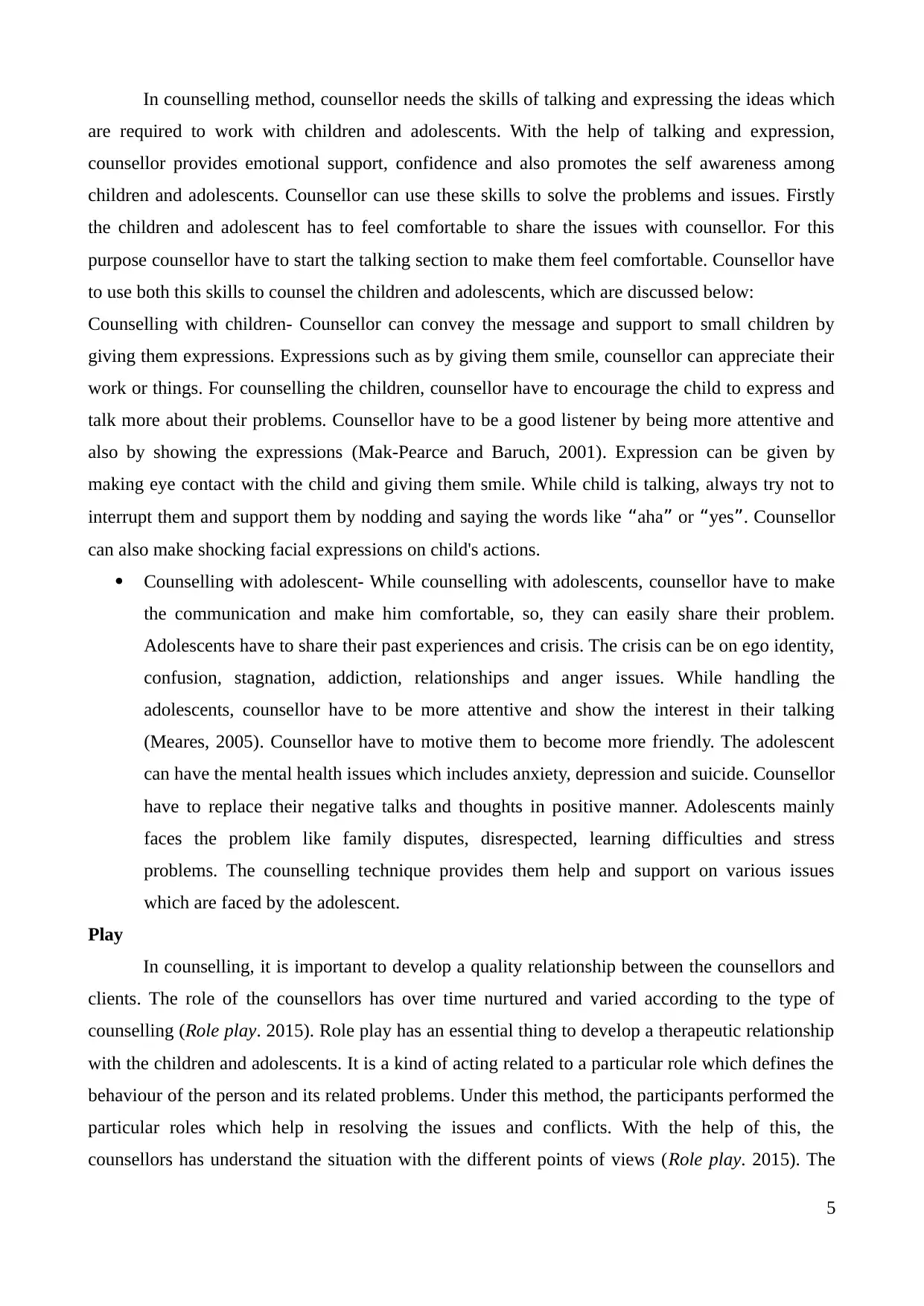
In counselling method, counsellor needs the skills of talking and expressing the ideas which
are required to work with children and adolescents. With the help of talking and expression,
counsellor provides emotional support, confidence and also promotes the self awareness among
children and adolescents. Counsellor can use these skills to solve the problems and issues. Firstly
the children and adolescent has to feel comfortable to share the issues with counsellor. For this
purpose counsellor have to start the talking section to make them feel comfortable. Counsellor have
to use both this skills to counsel the children and adolescents, which are discussed below:
Counselling with children- Counsellor can convey the message and support to small children by
giving them expressions. Expressions such as by giving them smile, counsellor can appreciate their
work or things. For counselling the children, counsellor have to encourage the child to express and
talk more about their problems. Counsellor have to be a good listener by being more attentive and
also by showing the expressions (Mak-Pearce and Baruch, 2001). Expression can be given by
making eye contact with the child and giving them smile. While child is talking, always try not to
interrupt them and support them by nodding and saying the words like “aha” or “yes”. Counsellor
can also make shocking facial expressions on child's actions.
Counselling with adolescent- While counselling with adolescents, counsellor have to make
the communication and make him comfortable, so, they can easily share their problem.
Adolescents have to share their past experiences and crisis. The crisis can be on ego identity,
confusion, stagnation, addiction, relationships and anger issues. While handling the
adolescents, counsellor have to be more attentive and show the interest in their talking
(Meares, 2005). Counsellor have to motive them to become more friendly. The adolescent
can have the mental health issues which includes anxiety, depression and suicide. Counsellor
have to replace their negative talks and thoughts in positive manner. Adolescents mainly
faces the problem like family disputes, disrespected, learning difficulties and stress
problems. The counselling technique provides them help and support on various issues
which are faced by the adolescent.
Play
In counselling, it is important to develop a quality relationship between the counsellors and
clients. The role of the counsellors has over time nurtured and varied according to the type of
counselling (Role play. 2015). Role play has an essential thing to develop a therapeutic relationship
with the children and adolescents. It is a kind of acting related to a particular role which defines the
behaviour of the person and its related problems. Under this method, the participants performed the
particular roles which help in resolving the issues and conflicts. With the help of this, the
counsellors has understand the situation with the different points of views (Role play. 2015). The
5
are required to work with children and adolescents. With the help of talking and expression,
counsellor provides emotional support, confidence and also promotes the self awareness among
children and adolescents. Counsellor can use these skills to solve the problems and issues. Firstly
the children and adolescent has to feel comfortable to share the issues with counsellor. For this
purpose counsellor have to start the talking section to make them feel comfortable. Counsellor have
to use both this skills to counsel the children and adolescents, which are discussed below:
Counselling with children- Counsellor can convey the message and support to small children by
giving them expressions. Expressions such as by giving them smile, counsellor can appreciate their
work or things. For counselling the children, counsellor have to encourage the child to express and
talk more about their problems. Counsellor have to be a good listener by being more attentive and
also by showing the expressions (Mak-Pearce and Baruch, 2001). Expression can be given by
making eye contact with the child and giving them smile. While child is talking, always try not to
interrupt them and support them by nodding and saying the words like “aha” or “yes”. Counsellor
can also make shocking facial expressions on child's actions.
Counselling with adolescent- While counselling with adolescents, counsellor have to make
the communication and make him comfortable, so, they can easily share their problem.
Adolescents have to share their past experiences and crisis. The crisis can be on ego identity,
confusion, stagnation, addiction, relationships and anger issues. While handling the
adolescents, counsellor have to be more attentive and show the interest in their talking
(Meares, 2005). Counsellor have to motive them to become more friendly. The adolescent
can have the mental health issues which includes anxiety, depression and suicide. Counsellor
have to replace their negative talks and thoughts in positive manner. Adolescents mainly
faces the problem like family disputes, disrespected, learning difficulties and stress
problems. The counselling technique provides them help and support on various issues
which are faced by the adolescent.
Play
In counselling, it is important to develop a quality relationship between the counsellors and
clients. The role of the counsellors has over time nurtured and varied according to the type of
counselling (Role play. 2015). Role play has an essential thing to develop a therapeutic relationship
with the children and adolescents. It is a kind of acting related to a particular role which defines the
behaviour of the person and its related problems. Under this method, the participants performed the
particular roles which help in resolving the issues and conflicts. With the help of this, the
counsellors has understand the situation with the different points of views (Role play. 2015). The
5
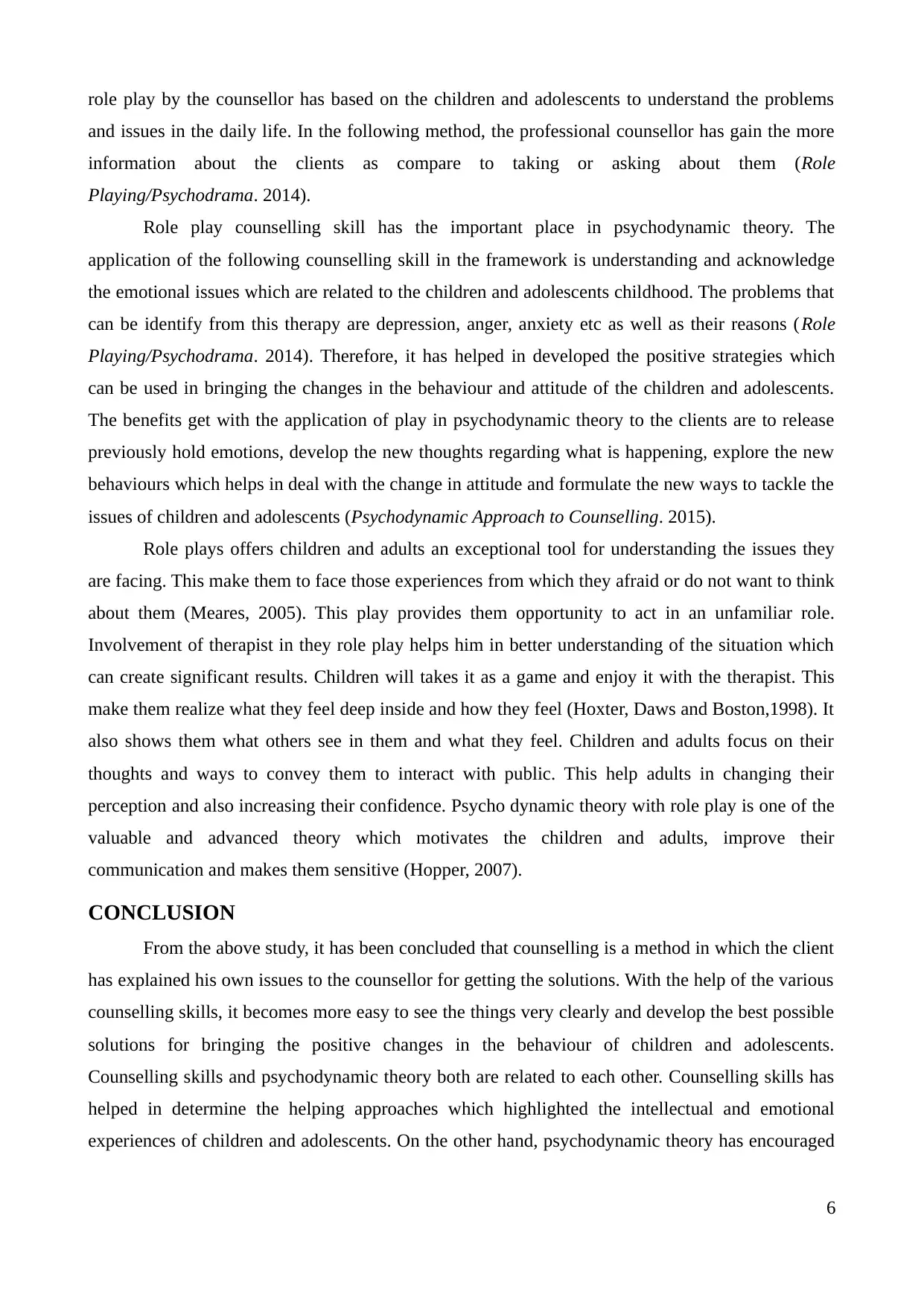
role play by the counsellor has based on the children and adolescents to understand the problems
and issues in the daily life. In the following method, the professional counsellor has gain the more
information about the clients as compare to taking or asking about them (Role
Playing/Psychodrama. 2014).
Role play counselling skill has the important place in psychodynamic theory. The
application of the following counselling skill in the framework is understanding and acknowledge
the emotional issues which are related to the children and adolescents childhood. The problems that
can be identify from this therapy are depression, anger, anxiety etc as well as their reasons (Role
Playing/Psychodrama. 2014). Therefore, it has helped in developed the positive strategies which
can be used in bringing the changes in the behaviour and attitude of the children and adolescents.
The benefits get with the application of play in psychodynamic theory to the clients are to release
previously hold emotions, develop the new thoughts regarding what is happening, explore the new
behaviours which helps in deal with the change in attitude and formulate the new ways to tackle the
issues of children and adolescents (Psychodynamic Approach to Counselling. 2015).
Role plays offers children and adults an exceptional tool for understanding the issues they
are facing. This make them to face those experiences from which they afraid or do not want to think
about them (Meares, 2005). This play provides them opportunity to act in an unfamiliar role.
Involvement of therapist in they role play helps him in better understanding of the situation which
can create significant results. Children will takes it as a game and enjoy it with the therapist. This
make them realize what they feel deep inside and how they feel (Hoxter, Daws and Boston,1998). It
also shows them what others see in them and what they feel. Children and adults focus on their
thoughts and ways to convey them to interact with public. This help adults in changing their
perception and also increasing their confidence. Psycho dynamic theory with role play is one of the
valuable and advanced theory which motivates the children and adults, improve their
communication and makes them sensitive (Hopper, 2007).
CONCLUSION
From the above study, it has been concluded that counselling is a method in which the client
has explained his own issues to the counsellor for getting the solutions. With the help of the various
counselling skills, it becomes more easy to see the things very clearly and develop the best possible
solutions for bringing the positive changes in the behaviour of children and adolescents.
Counselling skills and psychodynamic theory both are related to each other. Counselling skills has
helped in determine the helping approaches which highlighted the intellectual and emotional
experiences of children and adolescents. On the other hand, psychodynamic theory has encouraged
6
and issues in the daily life. In the following method, the professional counsellor has gain the more
information about the clients as compare to taking or asking about them (Role
Playing/Psychodrama. 2014).
Role play counselling skill has the important place in psychodynamic theory. The
application of the following counselling skill in the framework is understanding and acknowledge
the emotional issues which are related to the children and adolescents childhood. The problems that
can be identify from this therapy are depression, anger, anxiety etc as well as their reasons (Role
Playing/Psychodrama. 2014). Therefore, it has helped in developed the positive strategies which
can be used in bringing the changes in the behaviour and attitude of the children and adolescents.
The benefits get with the application of play in psychodynamic theory to the clients are to release
previously hold emotions, develop the new thoughts regarding what is happening, explore the new
behaviours which helps in deal with the change in attitude and formulate the new ways to tackle the
issues of children and adolescents (Psychodynamic Approach to Counselling. 2015).
Role plays offers children and adults an exceptional tool for understanding the issues they
are facing. This make them to face those experiences from which they afraid or do not want to think
about them (Meares, 2005). This play provides them opportunity to act in an unfamiliar role.
Involvement of therapist in they role play helps him in better understanding of the situation which
can create significant results. Children will takes it as a game and enjoy it with the therapist. This
make them realize what they feel deep inside and how they feel (Hoxter, Daws and Boston,1998). It
also shows them what others see in them and what they feel. Children and adults focus on their
thoughts and ways to convey them to interact with public. This help adults in changing their
perception and also increasing their confidence. Psycho dynamic theory with role play is one of the
valuable and advanced theory which motivates the children and adults, improve their
communication and makes them sensitive (Hopper, 2007).
CONCLUSION
From the above study, it has been concluded that counselling is a method in which the client
has explained his own issues to the counsellor for getting the solutions. With the help of the various
counselling skills, it becomes more easy to see the things very clearly and develop the best possible
solutions for bringing the positive changes in the behaviour of children and adolescents.
Counselling skills and psychodynamic theory both are related to each other. Counselling skills has
helped in determine the helping approaches which highlighted the intellectual and emotional
experiences of children and adolescents. On the other hand, psychodynamic theory has encouraged
6
⊘ This is a preview!⊘
Do you want full access?
Subscribe today to unlock all pages.

Trusted by 1+ million students worldwide

the clients to return to their previous experience to understand the reasons of present problems. The
most common counselling skills that has used by counsellors are role play, first encounter and
transference and taking and expressions.
7
most common counselling skills that has used by counsellors are role play, first encounter and
transference and taking and expressions.
7
Paraphrase This Document
Need a fresh take? Get an instant paraphrase of this document with our AI Paraphraser
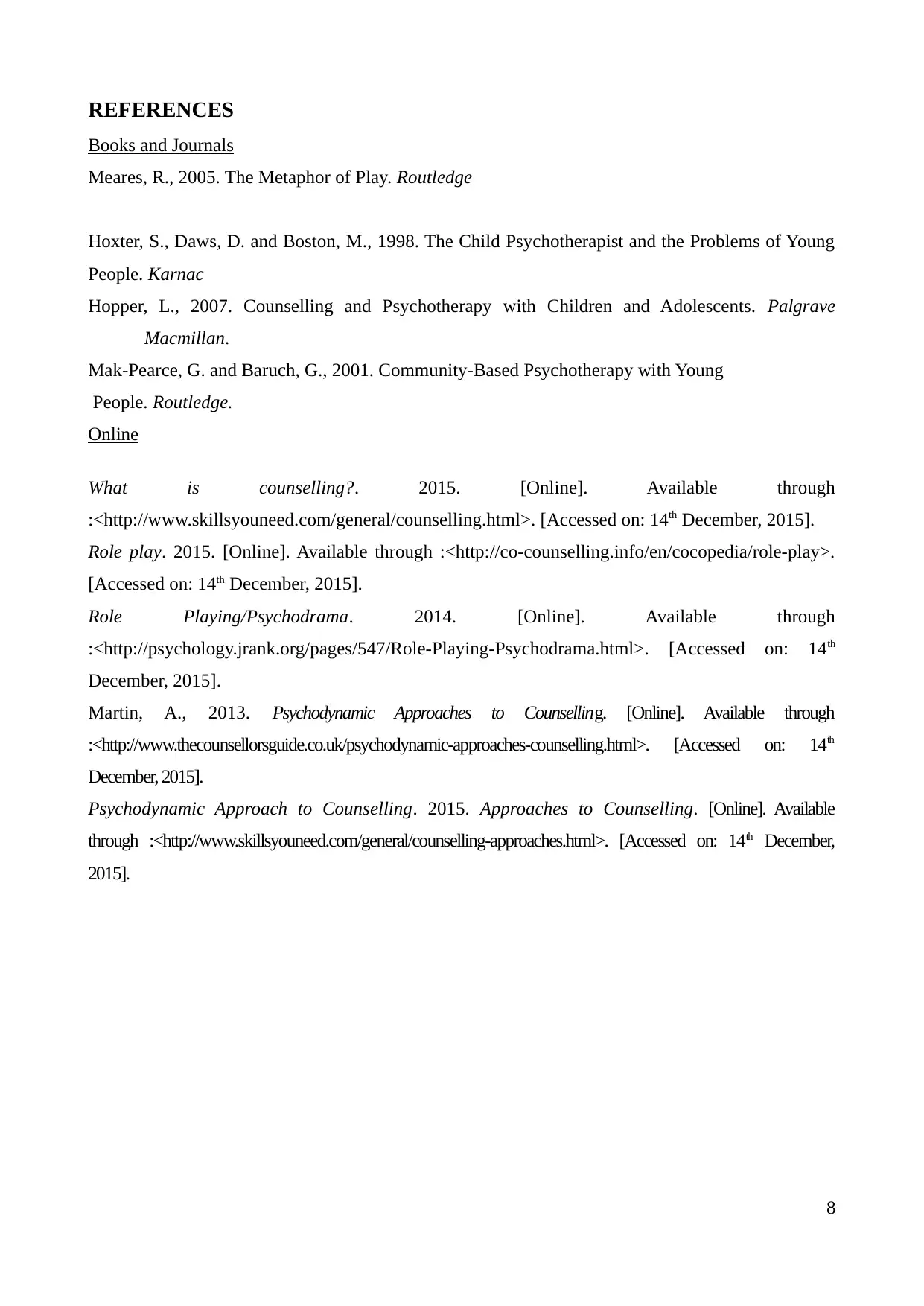
REFERENCES
Books and Journals
Meares, R., 2005. The Metaphor of Play. Routledge
Hoxter, S., Daws, D. and Boston, M., 1998. The Child Psychotherapist and the Problems of Young
People. Karnac
Hopper, L., 2007. Counselling and Psychotherapy with Children and Adolescents. Palgrave
Macmillan.
Mak-Pearce, G. and Baruch, G., 2001. Community-Based Psychotherapy with Young
People. Routledge.
Online
What is counselling?. 2015. [Online]. Available through
:<http://www.skillsyouneed.com/general/counselling.html>. [Accessed on: 14th December, 2015].
Role play. 2015. [Online]. Available through :<http://co-counselling.info/en/cocopedia/role-play>.
[Accessed on: 14th December, 2015].
Role Playing/Psychodrama. 2014. [Online]. Available through
:<http://psychology.jrank.org/pages/547/Role-Playing-Psychodrama.html>. [Accessed on: 14th
December, 2015].
Martin, A., 2013. Psychodynamic Approaches to Counselling. [Online]. Available through
:<http://www.thecounsellorsguide.co.uk/psychodynamic-approaches-counselling.html>. [Accessed on: 14th
December, 2015].
Psychodynamic Approach to Counselling. 2015. Approaches to Counselling. [Online]. Available
through :<http://www.skillsyouneed.com/general/counselling-approaches.html>. [Accessed on: 14th December,
2015].
8
Books and Journals
Meares, R., 2005. The Metaphor of Play. Routledge
Hoxter, S., Daws, D. and Boston, M., 1998. The Child Psychotherapist and the Problems of Young
People. Karnac
Hopper, L., 2007. Counselling and Psychotherapy with Children and Adolescents. Palgrave
Macmillan.
Mak-Pearce, G. and Baruch, G., 2001. Community-Based Psychotherapy with Young
People. Routledge.
Online
What is counselling?. 2015. [Online]. Available through
:<http://www.skillsyouneed.com/general/counselling.html>. [Accessed on: 14th December, 2015].
Role play. 2015. [Online]. Available through :<http://co-counselling.info/en/cocopedia/role-play>.
[Accessed on: 14th December, 2015].
Role Playing/Psychodrama. 2014. [Online]. Available through
:<http://psychology.jrank.org/pages/547/Role-Playing-Psychodrama.html>. [Accessed on: 14th
December, 2015].
Martin, A., 2013. Psychodynamic Approaches to Counselling. [Online]. Available through
:<http://www.thecounsellorsguide.co.uk/psychodynamic-approaches-counselling.html>. [Accessed on: 14th
December, 2015].
Psychodynamic Approach to Counselling. 2015. Approaches to Counselling. [Online]. Available
through :<http://www.skillsyouneed.com/general/counselling-approaches.html>. [Accessed on: 14th December,
2015].
8
1 out of 8
Related Documents
Your All-in-One AI-Powered Toolkit for Academic Success.
+13062052269
info@desklib.com
Available 24*7 on WhatsApp / Email
![[object Object]](/_next/static/media/star-bottom.7253800d.svg)
Unlock your academic potential
Copyright © 2020–2025 A2Z Services. All Rights Reserved. Developed and managed by ZUCOL.




